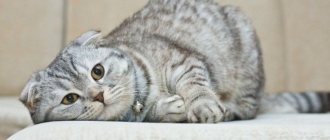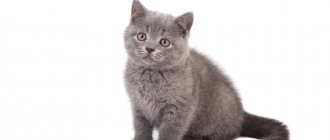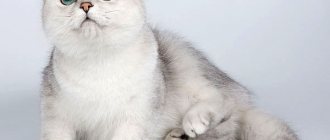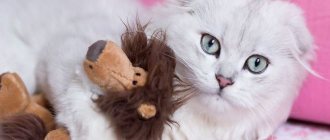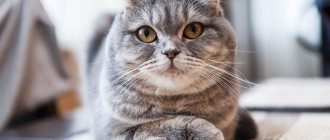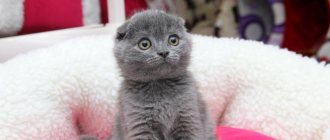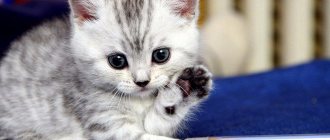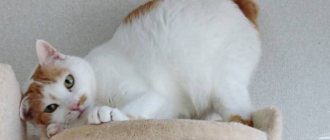( 2 votes, rating: 2.50 out of 5)
5589564
06/11/2021 owner reviews
Frisky, cheeky, cheerful, affectionate - a 6-month-old kitten is, in fact, a tiny baby wrapped in fur. If you've recently added a six-month-old baby to your family, find out how you can help him navigate it. We share what you need to know about a 6 month old kitten when it comes to health, mental wellbeing, behavior, diet and care.
- Vet visits for a 6 month old kitten
- Socialization of a 6-month-old kitten
- What to feed a 6 month old kitten
- Creating Good Habits
- Prepare your 6 month old kitten for grooming
- Summary of caring for a 6 month old kitten
What should you not give?
Most people think that cats' favorite food is milk and sausages.
In reality, everything is much more complicated. For a cat to be healthy, it must be taught a proper balanced diet from childhood. In addition to food that must be present in a kitten’s diet, there is a list of foods that are undesirable for consumption.
- Liver. It contains a huge amount of vitamin A and D. If this product is regularly fed, the animal’s body will become oversaturated with vitamins, which can lead to negative consequences. At the same time, pampering a kitten with liver is not prohibited. It can be given several times a week as a vitamin variety.
- Economy class dry food. Of course, they attract many breeders because they are inexpensive, but they contain a huge amount of harmful substances that, if consumed for a long time, negatively affect the health of the animal. Just look at the cost of dyes and all kinds of preservatives.
- Food made from legumes. They cause constipation and bloating. It acts on the cat's body and potatoes according to a similar principle.
- Fish. When a kitten is constantly fed fish products, the animal develops urolithiasis. To avoid such consequences, fish should be given no more than twice a week. And kittens under the age of one month should not be fed fish at all.
Below is a list of foods that are hazardous to a kitten’s health.
- Pickles, smoked meats, fatty and spicy foods. They contain a huge amount of seasonings that can harm the kitten’s intestinal microflora.
- Raw meat. This product can be included in the diet of kittens over 5 months. Younger cats need to boil meat products.
In this case, it is proposed to consider products that can lead to the most tragic consequences - death. Moreover, the death of the animal will not occur immediately, but after a certain period of time.
- Sweets. For a small kitten this is real poison. The animal's body by its nature is not adapted to eating chocolate. It’s good that not every individual eats candy or cookies.
- It is very dangerous to give fish skeletons and bird bones to a kitten. Their structure, when chewed, can cause irreparable harm to the animal’s body. When a cat chews bones, pieces of the skeleton break up into fragments with sharp ends. They get into the stomach, and accordingly, they can scratch the esophagus or even puncture it, which leads to internal bleeding.
- Expired products. Any food that has long expired is a breeding ground for many pathogenic bacteria and putrefactive microorganisms. This food will not lead to anything good, especially if you feed it to a small kitten.
The information presented will help novice breeders feed a newborn kitten and raise it into a healthy adult cat.
In the next video you can find out what breeders feed small kittens.
Origin story
The only significant difference between Scottish Straight cats and Scottish Fold cats is in the ears. They are not curved, but straight - that’s the whole difference. These cats appeared in the 60s of the last century on an ordinary Scottish farm, and initially the cats’ ears were folded. Breeders, having started breeding a new breed, quickly found out: in litters, both kittens with curled ears and normal ones are usually born, and in addition, the gene responsible for the lop-eared gene negatively affects the health of animals.
The cats' bones thickened, early osteochondrodysplasia appeared, and they died early. Through trial and error, it became clear: the best option for crossing is a cat with straight ears and a fold-eared cat.
The Scottish Straight breed was officially registered in 2004 and immediately became extremely popular.
A kitten not for breeding costs about 5,000 rubles (without documents) and 10,000 rubles with documents. Show-class specimens will cost 18-25 thousand rubles.
Features of care
Small pets at 2 months are still very fragile creatures and are susceptible to various infections and parasites. It is necessary to especially carefully monitor their health, give them vaccinations at the right time, and carry out deworming. If you have any concerns or concerns regarding nutrition or health, please contact your veterinarian immediately. Observe the appearance and behavior of your pet: it should be well-fed with shiny fur and active in games
Particular attention should be paid to the constant availability of fresh water for the kitten, especially when feeding with commercial food.
Determining the age of a cat by external signs
If the cat does not have documents and came into the house as an adult, you can find out the approximate number of years she has lived by her appearance:
- According to the condition of the teeth. This is the most accurate way to determine a cat's age. A one-month-old kitten already has baby teeth. At the age of six months they are completely replaced by the indigenous ones. By 18 months, grinding of the central lower incisors begins. By the age of 2 years, yellow discoloration appears on the tooth enamel. In five-year-old cats, the incisors noticeably wear out and the fangs begin to deteriorate. At the age of 9, cats have almost completely worn down all their lower teeth, and by the age of 10, their upper teeth are worn down. By age 15, many animals have lost most of their teeth.
- According to the condition of the coat. Until about 7 years of age, all cats have a healthy, shiny coat without bald spots or gray hair. From the age of eight, the quality of wool begins to deteriorate. The hairline loses its natural shine and becomes thinner. Often at this age, cats develop bald spots, mats and gray hair.
- According to the condition of the musculoskeletal system. During the period of youth and maturity, cats have prominent muscles, ease of movement and increased endurance. After 8 years of age, animals begin to experience a decrease in muscle tissue volume and a noticeable decrease in activity. At this age, cats' spine sags, their shoulder blades protrude, and their movements become stiff.
- According to the condition of the eyes. This is the most unreliable way to calculate a cat's age. The eyes of adolescents and adult animals are practically no different from each other. And only by the age of 10 can one notice signs of aging. At this age, the iris becomes blurry, faded and cloudy.
On a note. All these methods allow you to approximately calculate the age of a cat. But when using them, it is necessary to take into account the living conditions, health and nutritional quality of the animal.
Formative nutrition: from the first month to six months
Now all the sleepless nights are over and your kittens begin to confidently stand on their feet, get out of the nest, bully each other, run to the kitchen in search of food - in a word, the body has survived and its active formation has begun. During this period, the main body weight gain occurs. Every day the kitten asks for more and more food, sometimes it becomes capricious, turns up its nose, and sometimes it devours the entire portion; all you have to do is replenish the bowl.
At this age, breeders should provide the baby with food in sufficient quantities so that he always has enough energy for development and play. In addition to calories, during this period of life a kitten needs to consume all the building material from which its body will be formed, and, consequently, its future health. To do this, breeders begin gradually feeding babies a wide variety of foods.
The calculation of the number of feedings during this period is still determined by weight. Now 1 kg is taken as a basis. The daily dose for a kilogram kitten is 150-250 grams of a balanced diet. This means that your daily intake should include proteins, vegetables, cereals and fermented milk. Moreover, in the first month their ratio will be more towards liquid mixtures, and by the fifth month the diet should already contain more meat products. The most common scheme looks like this:
- 1st and 2nd months - 5 meals a day: every 4 hours, skipping one night feeding (break 8 hours);
- 3rd and 4th months - 4 meals a day: every 4 hours, skipping two night feedings (12 hour break);
- 5th and 6th months - 3 feedings per day.
Although the kitten eats less and less every month, this does not mean that it needs to be fed less and less. In no case! On the contrary, now is the time to eat a lot, even more adult cats. It’s just that now the portion size should increase, since the kitten’s stomach expands every day. It is no longer a problem for your baby to fit the right amount of food into it at one time. In the morning, it is advisable to give fermented milk, in the afternoon - mixtures of cereals, vegetables and meat, in the evening - meat products (so that the hunter sleeps at night and does not look everywhere for the treasured game).
Diseases
The most common problems are:
- Discharge from the eyes. This is not necessarily a sign of an illness: it is often due to the specific structure of the skull and narrow tear ducts. If the discharge is clear or brown and odorless, there is nothing to worry about. But an admixture of yellow or red pus is a signal of a problem.
- Otitis, ear mites, fungus. If your pet constantly shakes its head and seems to be trying to get something out of its ear, take it to the vet. Maybe something got inside, maybe you scratched the delicate skin while cleaning, or maybe it’s due to the onset of a disease.
- Joint problems (eg osteochondrodysplasia). Over time, the bones become deformed, which is why the animal begins to experience difficulties when walking: it cannot fully straighten its paws, and it is difficult for it to jump.
- Urolithiasis disease. Castrated males are more likely to suffer from this disease. There may be several reasons: lack of vitamins, hormonal imbalance, severe cold, infection, poor diet. The animal begins to run around frequently, stops eating, becomes lethargic, licks itself frequently, and blood is visible in the urine.
- Excess body weight. Scottish Straight cats are prone to obesity, so their diet should be monitored especially carefully.
Expert opinion
Dusheba Vera Ivanovna
In 2010, she graduated from the Moscow State Academy of Veterinary Medicine named after K.I. Scriabin with honors, specializing in veterinary medicine. I regularly attend veterinary conferences, congresses, and webinars.
Whether or not to vaccinate your pet is up to each owner to decide for himself. But remember: you can bring pathogens into the house on your hands, clothes, and shoes. In this case, even thorough washing and disinfection of the premises may not save the animal from infection. Distemper, panleukopenia, calcivirosis, rabies are mortally dangerous and without vaccinations your beloved creature will face a painful death. In addition, without vaccinations you will not be able to take your cat abroad.
Feeding standards
The amount of food per meal depends on its type and type of feeding. Veterinarians recommend keeping domestic cats on a natural diet, regularly using vitamin and mineral supplements, and following a two-time feeding regimen (morning and evening).
An adult healthy animal should be provided with at least 10 g of protein, 2 g of fat, 1 g of carbohydrates, 1 g of fiber per 1 kg of weight per day. The daily energy value for natural feeding should be at least 40 kcal per 1 kg of weight.
If the owner buys ready-made food for his fluffy dog, he must strictly adhere to the dosage indicated on the packaging. Finished products of different brands differ in the quality of raw materials, preparation technology, and composition. For example, for a healthy adult cat weighing 4 kg, the average amount of dry food per day is 60-70 g, divided into two meals.
Important! Depending on the composition of the feed, its purpose and class, the dosage may differ slightly for animals of the same weight category. The higher the product class, the lower the feed consumption
All ready-made food is completely balanced and nutritious. Premium, super-premium or holistic products undergo numerous quality checks, are safe for animals and are economical.
Super-premium and higher class food is most suitable for the animal
The main parameter by which the required amount of ready-made food per day is determined is the weight of the animal. To ensure full life activity, per 1 kg of adult weight there should be 30-60 g of food containing 60-70 kcal.
Below are tables showing how much dry and wet food a cat needs per day:
How much dry food do you need per day?
Ready diet
With a ready-made diet, Abyssinian kittens are fed wet, dry, semi-moist industrial food, canned food, and high-quality pates. The prepared diet should be varied. You should not feed your pet only, for example, dry food or wet food. Combine dry pads with canned food, pates, and treats for kittens.
Advantages of ready-made diets:
- no need to waste time preparing a varied menu for the cat;
- the brand line includes food for kittens of various age groups;
- dry food has a long shelf life;
- the manufacturer indicates the approximate daily allowance by age on the packaging;
- large selection of flavors.
The line of well-known brands also includes products for weakened animals, for kittens with a sensitive gastrointestinal tract, and pets prone to food allergies.
The best food for Abyssinian kittens:
- Royal Canin.
- Hill's.
- ORIGIN.
- Acana.
- Nutra Gold.
High-quality feed has a balanced composition and contains all the necessary nutrients, vitamins, microelements, and amino acids. Holistics are intended for nutrition of Abyssinian kittens with sensitive digestion. Contains probiotics and enriched with B vitamins.
Ready-made feed
The opinions of veterinarians regarding which food to prefer - natural or ready-made specialized food - do not coincide. The main advantage of ready-made food is that there is no need to introduce special complementary foods, as with natural nutrition, since it already contains fortified supplements. But there is also a significant drawback - the addition of flavors and preservatives, which can harm the health of babies.
If you decide to feed your pet prepared food, you need to remember the rules:
- Do not mix dry and wet food together;
- stick to a particular brand of food and change it only if absolutely necessary.
When choosing ready-made food, you need to carefully study the products of manufacturing companies. Find out whether it is possible to use their food, combine dry and wet canned food, and in what quantity to give them. According to veterinarians’ recommendations, from four months onwards, a kitten can be given the entire daily portion at once: it already knows how to control the amount of food it eats. It is better to pour wet canned food in sauce and jelly in the quantity required for a single meal. In case of a possible combination, the daily diet of a pet, according to the recommendations of experts, should consist of 3 quarters of dry food and 1 quarter of canned food.
Without causing harm to the baby’s health, you can use the following foods:
Acana
One of the best proven super premium food series. It provides a complete balanced diet and is the best hypoallergenic food. The food is produced in its own juice. The composition includes only whole and fresh ingredients. It contains meat ingredients, vegetables, fruits, seaweed, fresh eggs, polyunsaturated fats, proteins and proteins in optimal quantities.
Royal Canin
Dry food from this company is the best substitute for natural food, as it contains the substances necessary to maintain the life and activity of a kitten. The brand’s “medicinal” line is especially popular. The composition of veterinary feeds from this company is ideally balanced and takes into account the characteristics of a particular disease. Suitable food for kittens aged 4-12 months.
What does a kitten's weight depend on?
During the first two months of a kitten’s life, it is recommended to weigh it daily, and once a week after reaching two months of age. In this case, it is advisable to perform the procedure at the same time of day.
To monitor normal development, you can use the following table of a kitten’s weight by month. It is worth considering that an alarming signal is not only low, but also excessively high weight, which may indicate poor nutrition, a sedentary lifestyle, hormonal disorders and other problems.
The following factors influence the baby's weight:
- Breed. To control the weight of kittens by month for large breeds such as Savannah, Maine Coon or Ragdoll, special tables should be used.
- Floor. After several months of development, boys overtake girls in size and weight.
- Number of kittens in the litter.
- Balanced nutrition for cats during pregnancy and lactation.
- The presence in the kitten’s diet after switching to independent feeding of the entire complex of necessary vitamins, minerals and other substances.
- General health. Diseases and the presence of parasites can lead to developmental delays.
Vitamins and supplements
When kept on high-quality, industrial feed, vitamins and additives are not required
It is important to understand that an excess of vitamins and microelements is no less dangerous than their deficiency. With a natural feeding method, vitamin supplements should be present in the diet on an ongoing basis at least until the age of one year.
A kitten can get basic vitamins and nutrients from natural products:
- Meat and bone meal.
- Fish, chicken, beef liver.
- Greens, vegetables, fruits.
- Sunflower oil, olive oil.
- Brewer's yeast.
Taurine is a rare amino acid that is found in small quantities in:
- Turkey.
- Rabbit.
- Chicken heart and liver.
- Beef heart.
- Pork, after deep freezing.
- Boiled pork liver.
- Ocean fish and shellfish.
- Raw red fish.
- Live homemade yogurt.
- Whole milk.
Do not forget that pharmaceutical products are also sources of vitamins and nutrients:
- Fish fat.
- Feed tricalcium phosphate.
- Omega-3, Omega-6.
- B vitamins.
To make life easier for owners, stores and veterinary pharmacies sell basic vitamin complexes containing essential nutrients and taurine. Veterinarians recommend choosing several complexes with a short composition, but alternating them on an ongoing basis.
Vitamins and supplements
A kitten's growing body must receive all the vitamins and mineral supplements necessary for health and development. There are complexes on sale designed for kittens starting from 2-3 months of age. It is best to use complex preparations (Gamavit, Tetravit, Trivit). At the same time, we note that vitamin supplements are necessary when keeping a pet on a natural diet. High-quality industrial feeds have a completely balanced composition and already contain all useful substances.
From available means, the diet is enriched once a week with fish oil (one drop for each feeding), dry yeast, and meat and bone meal.
Weight table by month
The Scottish Straight weight gain graph is clearly demonstrated in the table by month.
| Age | Female (weight in kilograms) | Male |
| 1 month | 0.3-0.65 g | 0.45-0.75 g |
| 2 | 0.45-0.8 g | 0.8-1.6 |
| 3 | 1.25-1.7 | 1.3-2.4 |
| 4 | 1.7-2.35 | 2.1-3.8 |
| 5 | 2.25-3.1 | 2.45-4.2 |
| 6 | 2.3-3.5 | 3.1-5.5 |
| 8 | 2.9-4.3 | 3.4-6 |
| 10 | 3.1-4.6 | 4.2-7.2 |
| 1 year | 3.2-5.3 | 4.6-7.4 |
| 2 and older | 3.4-5.6 | 5.3-8.2 |
Feeding rates depending on age and weight
Until the age of six months, the kitten gains 100 grams of weight per week. At six months, the animal’s growth stops, but its weight continues to increase. However, these indicators do not apply to each individual, since there are breed characteristics. For example, the final weight and size of a Maine Coon is established only at two years, and until this age a pet of this breed grows quite slowly.
The older a kitten gets, the less energy its body expends, which means that as it grows, the amount of daily food should be reduced. So, if a very tiny baby needs 48 g per 1 kg of weight per day, then from 4 months this portion decreases to 32 g per day, and from 7 months this figure is completely equal to 24 g. To accurately calculate the feeding rate, you can use with a regular measuring cup. It is sold at the pet store.
Summary of caring for a 6 month old kitten
In short, you can help your kitten develop into a friendly and affectionate adult cat by taking the time to show him that the world is a safe place. As Pam says, “Kitten is a wonderful and fun time, but it is also a time for him to learn and process the experience. The more time you spend gradually introducing your kitten to new things, the more likely he is to be more receptive to these experiences later in life, which will reduce everyone's stress levels."
About the Author Stacy N. Hackett, a lifelong cat owner, writes frequently about cats, cat breeds, and a variety of pet-related topics. Her writing inspiration comes from her cats, Jack and Katie, and her cocker spaniel/labrador mix, Maggie.
Are there any peculiarities in feeding small kittens of different breeds?
Feeding different kittens may vary depending on the breed.
Caring for any breed has its own nuances. For example, it is not customary to give liver to babies of Russian Blue cats and Gray Nibelungs. It is believed that this product gives the fur a brown tint, although many breeders recommend feeding kittens with liver from at least one and a half months. It is recommended to feed British kittens a nutritious diet. Britons are stocky animals, kittens grow quickly, rapidly gaining weight, but these animals cannot be called lazy. The diet of such a kitten should contain at least 65% meat products, and vegetables - about 25–30%.
Scottish kittens (Scottish Folds and Scottish Straights) under 3 months of age should eat at least 6 times a day. Active cats quickly begin to feel hungry. Some owners of Scottish cats note that the more nutritiously you feed the kitten, the better its coat “fills up.” I had to read recommendations and advice on feeding Scottish cats on forums. One breeder wrote that the more difficult it is to prepare porridge (4-5 grains at a time), the thicker the animal’s fur becomes. And some even choose a mixed type of feeding. Moreover, kittens are given high-calorie foods as an additive to store-bought food.
Scots need to be fed often and nutritiously
There is a lot of controversy about the nutrition of small Maine Coons. However, every breeder recommends closely monitoring the baby’s diet. Cubs grow large; a three-month-old kitten can be the size of a regular adult cat. The food for such cats should be dense and plentiful, but the kitten should not be overfed (regular overfeeding leads to obesity and other problems).
With ready-made food, everything is much simpler. Manufacturers of elite baby food take into account the characteristics of breeds. For example, Royal Canin, which produces food for 6 different breeds of kittens, has developed the British Shorthair series. This food is presented in the form of large granules of a special curved shape. The busy British cannot swallow such an “inconvenient” faction; they have to chew it. In addition, the packages of store-bought food always indicate the daily intake for a kitten, the volume of a single serving and other details.
Creating Good Habits
Your six month old kitten is definitely becoming more individual and developing behaviors that he will follow throughout his life. Kitten - 8 weeks to about one year of age is the ideal time to help your pet develop good habits to make him a model pet into adulthood and beyond.
“Take time to help your kitten become comfortable with the experiences he will encounter in his life: car rides, grooming, ear cleaning, teeth brushing, nail trimming, unfamiliar surroundings, unfamiliar sounds, unfamiliar people in his house, etc. etc.,” says Pam. She also gives tips on how to help your kitten learn good litter box habits.
First, if you haven't already, provide a litter box that is easy for your kitten to climb into. “A litter box with high sides will be too difficult for a teenager, especially one with a full bladder,” she says. "Keep in mind that a kitten won't have the bladder control that an adult cat does, so when he needs to go to the toilet, it's usually urgent."
You can start offering a larger litter box once your kitten is 6 months old and becomes more familiar with using the litter box. “Place a larger cell next to a smaller one to begin the gradual transition,” suggests Pam. "You can even place a smaller litter box inside a larger one so she can get used to the new environment."
The need for water in the diet
Water plays a key role in a pet’s diet, since the full functioning of metabolic processes and hematopoiesis depends on the water-salt balance. If metabolic processes in the body slow down, the development, growth and functioning of all organs slow down along with them. Thick blood is one of the reasons for slow metabolism, problems in the functioning of the cardiovascular system and other organs.
Make sure that drinking bowls with clean water are available to your pet at all times, especially if he eats industrial food. The water in drinking bowls should be changed at least once a day, in hot weather 2-3 times a day. Be sure to wash bowls to remove plaque, as it is a source and fertile ground for the proliferation of pathogenic bacteria.
Prepare your 6 month old kitten for grooming
The gradual introduction of new products also applies to care tools. As you get your 6 month old kitten accustomed to regular handling of his paws, mouth and body, you are helping him prepare for regular grooming tasks. Brushing sessions can be a great time for you to bond with your pet, and if he is already accustomed to your touching his paws and mouth, he will be more receptive to additional grooming tasks such as nail trimming and teeth brushing.
How much should a cat eat per day?
To keep your pet healthy and alert, its diet must be nutritious and balanced. It is the nutritional value of the product that determines how many times a day you need to feed your cat. The amount of food eaten during the day should be no more than 7.5% of the animal’s weight.
The dosage of ready-made food is indicated on the packaging, and with natural feeding, the cat needs to eat up to 150 g of meat or fish per day, which is 50% of the daily protein intake. The natural diet is supplemented with fermented milk products, cereal porridges, seasonal vegetables, vitamins and mineral nutritional supplements. Meal frequency – 2 times a day.
- Can I have a piece?
The diet of a pregnant cat should have an increased energy value: contain more vitamins and minerals, but not increase the calorie content of the product. Increase the frequency of feedings up to 4-5 times, maintaining the usual serving size. A nursing cat is also provided with frequent feeding, while increasing the volume and calorie content of food.
Note! It is better to prepare the diet for a pregnant or lactating cat after consultation with a veterinarian
Character and behavior
Looking at the imposing and massive Scottish Straights, you might think that they are lazy and do not see beyond their food bowl. Not at all! Of course, among cats of this breed (as well as among individuals of other breeds) there are many phlegmatic animals, but not all have such a specific character. Scottish Straights are reasonable and careful, they look closely and think for a long time before taking on any business, but this does not mean at all that they are stupid or slow.
Scottish Straights can run as fast as their feline counterparts and love new toys and running around. They just need a little more rest and quiet. They are not hermits or beeches: Scottish Straights love to be the center of attention, but they also easily tolerate loneliness.
The peak of playfulness occurs in the first couple of years of their life; for the rest of the years, cats prefer a leisurely existence in comfort and coziness, next to their favorite representatives of the human race.
They are careful, restrained in expressing feelings, but affectionate and very patient. These are the same cats that you can have in a family with small children. Scottish will never allow himself to scratch a child or scare him with a loud hiss. If the cat is “pushed”, he will silently run away and hide, but will not take revenge. They are not vindictive or vindictive, and do not suffer from mood swings, but they can be very persistent and even obsessive. If they really want something, they will follow you on your heels and scream until victory.
Name the cat who always wanted to live together
BasilioLeopold
They respond well to learning basic skills - going to their litter box (How to train a kitten to use the litter box?), eating at certain hours, not stealing from the table - but training is not for them. They get along well with other cats and even dogs, but they do not like small animals.
A change of environment is difficult for them, as is moving. They are afraid of heights, loud sounds and do not like water.
Water in a kitten's diet
Water plays a fundamental role in metabolic rate and the process of hematopoiesis. If dehydrated, a one and a half month old kitten can die within a few hours. Before switching to adult food, make sure that the kitten knows how to drink water and does it willingly. Every time after eating, make sure that the kitten goes to the drinking bowl.
If a one and a half month old kitten does not drink water, the reason may be that he does not know how to do it. To teach your kitten to drink from a bowl, wet your finger and gently touch the kitten's nose. The baby will instinctively lick his face and if he is thirsty, he will become interested in the contents of the drinking bowl.
Vet visits for a 6 month old kitten
If you haven't taken your 6 month old kitten to the vet yet, now is the time! For kittens who have already been to the vet, schedule an examination when your feline friend reaches the 6-month mark. At your appointment, you can expect your veterinarian to perform a thorough examination of your kitten's eyes, ears, mouth, and body. He will want to make sure your kitten is developing properly.
Your veterinarian may also recommend vaccinations if your kitten has not yet received them, as well as spaying or neutering. Have this surgery done while your pet is still young to prevent unwanted behavior such as territorial marking.
© shutterstock
How many times a day should I feed?
Since the small kitten is still small, it is important to provide the correct amount of food at each meal. It is age that affects the frequency of feedings and portion sizes
It is recommended to give your pet food often, but in small quantities, otherwise you can provoke the development of diseases of the digestive tract.
The optimal feeding option based on age:
- a one-month-old kitten should be fed 6 to 8 times a day;
- two months - no more than 5 times a day;
- three-month - 4 times;
- starting from 4-5 months and up to a year, the pet is fed no more than three times a day;
- When the cat is old enough, you can switch to two meals a day; it is recommended to do this no earlier than one and a half years.
A newborn kitten eats only mother's milk and does not need other food. At 1 month he no longer has enough such nutrition and it is necessary to introduce new food. It is best to start with dairy products (ryazhenka or kefir). Such products are poured into a bowl, which allows you to accustom your pet to eating independently in a designated place and from a certain container.
At 2 months, the kitten’s diet becomes wider and more varied; vegetables are introduced, which, along with the meat, are no longer ground, but finely chopped. Dairy products are still important and should make up a large part of the diet. At three months of age, you can switch to full feeding, a quarter of which consists of dairy products (but not milk in its pure form). The diet should also include cereals, meat and vegetables, which are cut into large pieces. If desired, you can let your pet try vegetables raw.
As for the amount of food in one serving, approximate calculations are made according to the scheme - 150 g of food per 1 kg of kitten weight. These data may vary depending on the calorie content of the food. In the case of ready-made food, the packaging already indicates the norms for each age group.
For information on what to feed your kitten, watch the following video.
Socialization of a 6-month-old kitten
Your veterinarian may also ask about your kitten's social behavior. At 6 months of age, your kitten will become increasingly curious about its world, but will need to learn to interact with other animals and people to remain a friendly and sociable pet.
“In the first months of life, kittens need interactions with their own species and other species to develop social skills,” says Heidi Pavia-Watkins, DVM, of Irvine Airport Animal Hospital in Costa Mesa, California.
One of the best ways to bond with your kitten is to simply spend time with it. Give him a hug, stroke his fur, look tenderly into his mouth, and gently stroke his paws. Regular handling will also help you when it comes time to trim his nails or brush his teeth - he's already used to you touching his mouth and feet.
While your 6-month-old kitten is still at this curious young age, introduce him to new people of all ages. Inform friends that they should approach your kitten slowly and not force themselves on him—the goal is for your kitten to find new people safe, not scary.
This is also a great age to help him learn to love (well, at least not fear) the carrier. "Keep the carrier out of the way and feed your kitten there regularly, toss treats in there, and create a cozy sanctuary by lining the carrier with a soft towel," suggests Pam Johnson-Bennett, a certified cat behaviorist. “Periodically, put the kitten in a carrier, carry him around the house, and also take him for walks in the car.”
Feeding mode
The feeding regimen is set depending on the breed, weight, activity, and health of the animal. The larger and more playful the kitten, the more food it needs to develop normally.
Veterinarians advise creating a different menu for each week. The number of feedings for a four-month-old kitten is 4 main meals and 1-2 snacks.
150–200 grams of food per 1 kg of body weight per day will be enough. The total amount of food is divided evenly into the number of meals.
Allowed snacks are boiled chicken yolk, a piece of meat or fish, a small portion of cottage cheese. If the kitten does not eat vegetables, they can be replaced with grass or vitamin supplements.
Lifespan of cats
Cats live on average 14-16 years. Their life expectancy is influenced by many factors, including the attitude of the owners, breed, living conditions, quality of feeding and previous diseases.
Interesting! The absolute record holder for life expectancy is a cat named Cream Puff. She lived for 38 years and was included in the pages of the Guinness Book of Records.
None of the existing methods for translating the age of a cat reflects the individual characteristics of a particular animal. And in order to provide a cat with decent living conditions, it is not necessary to recalculate the years he has lived in human years.
